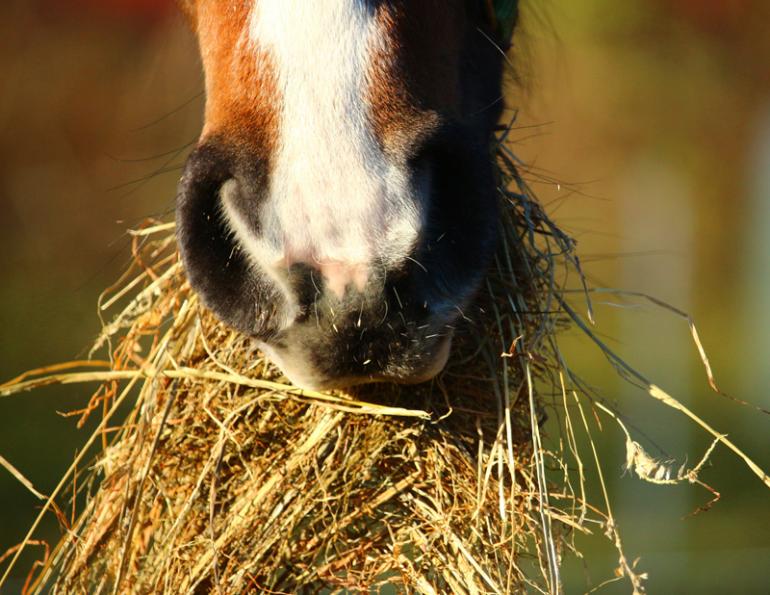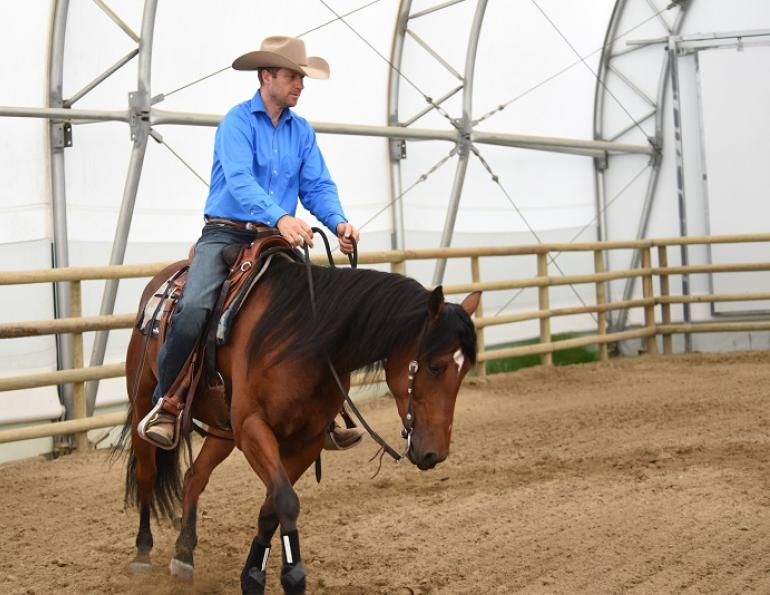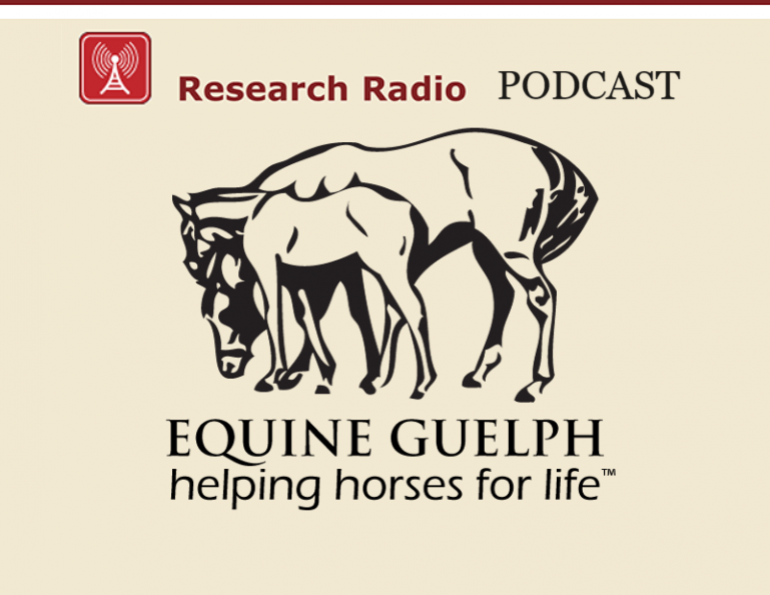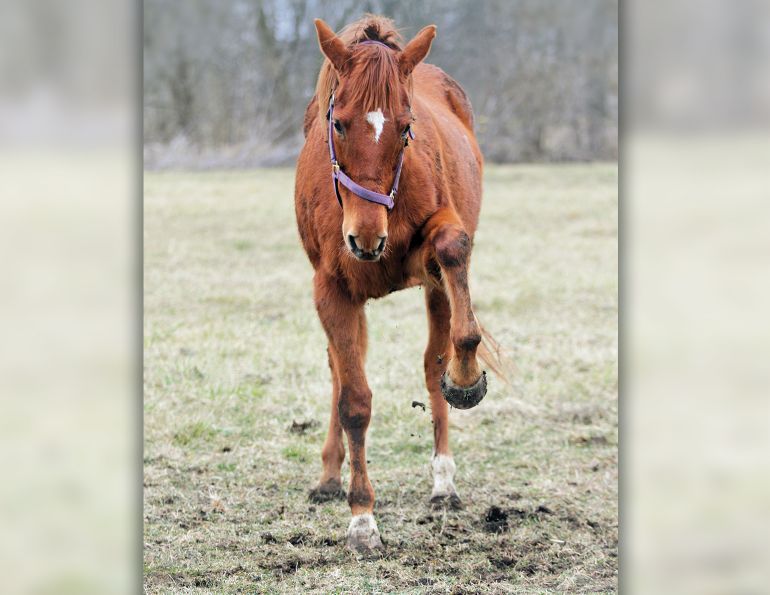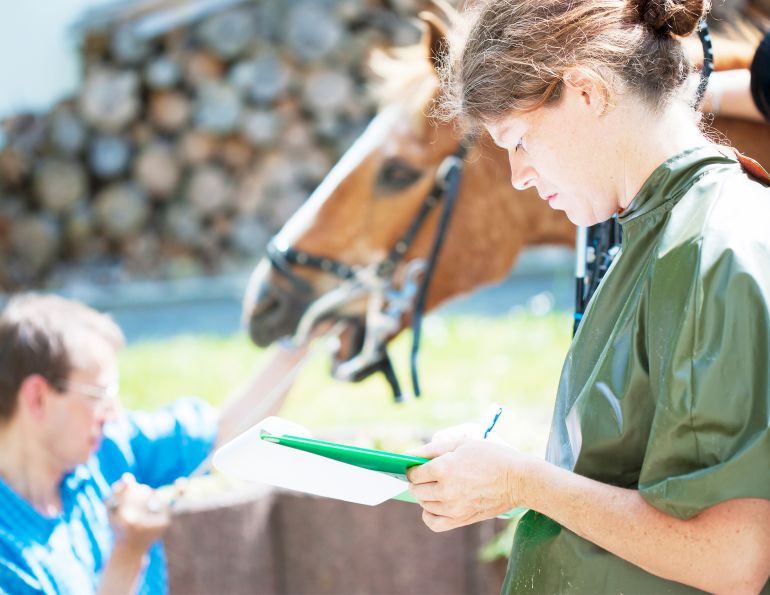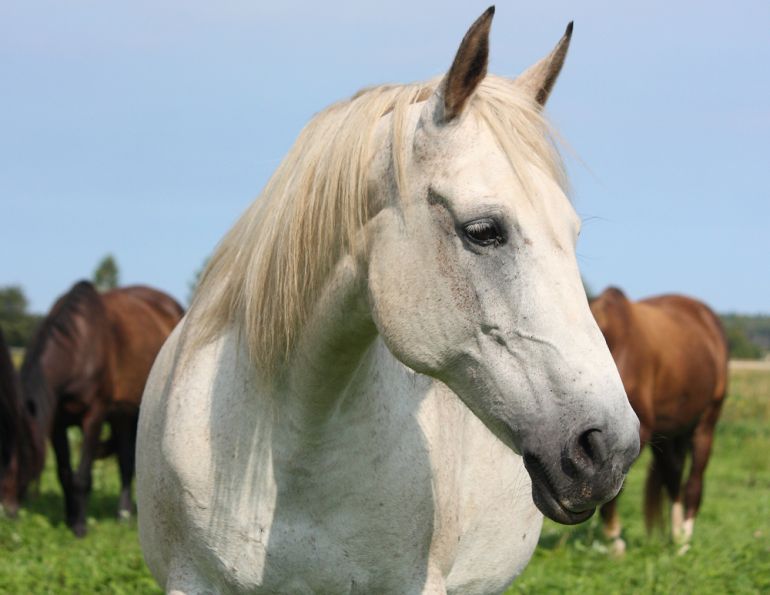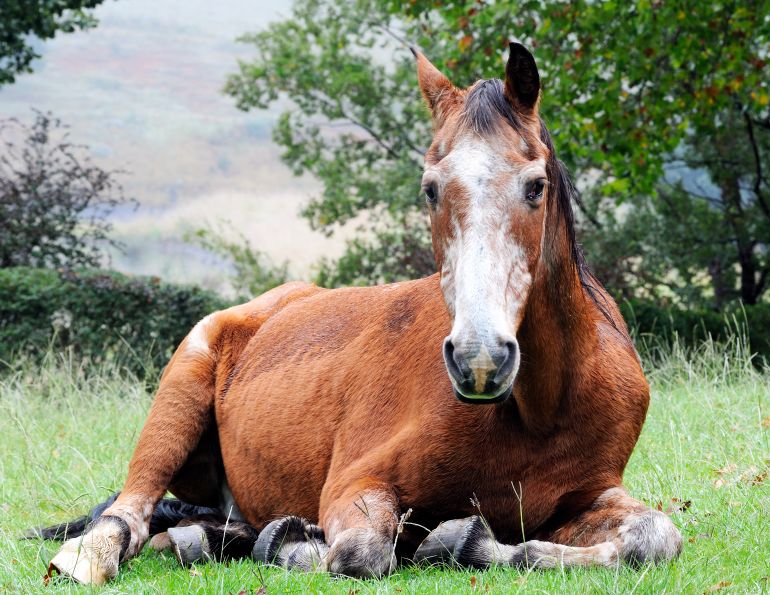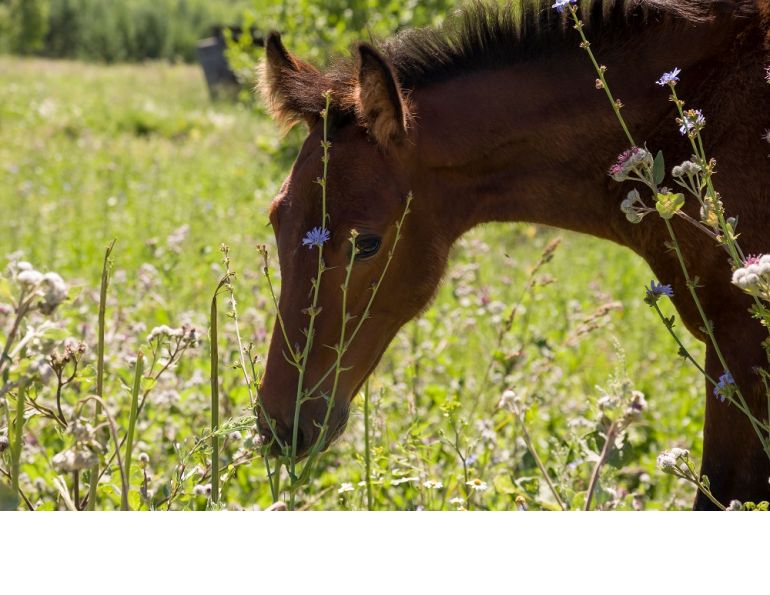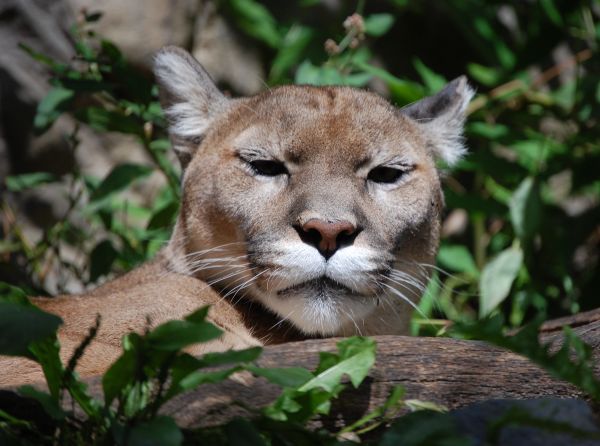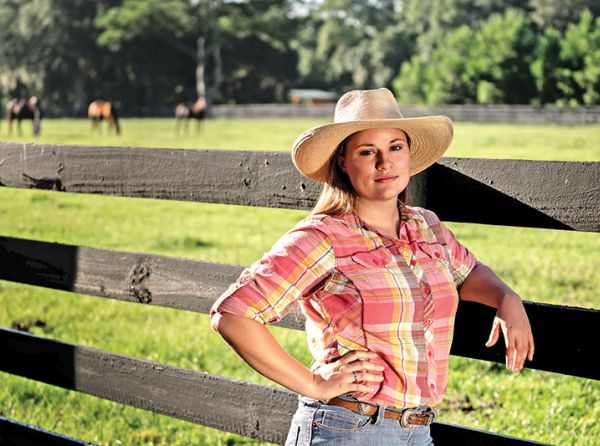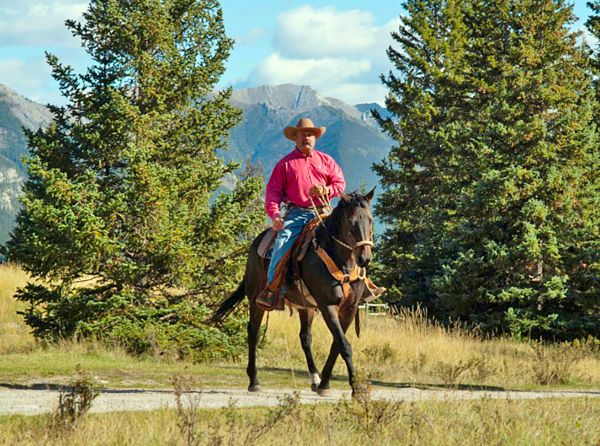By Shelagh Niblock, PAS
When fall days turn shorter and colder as the seasons change, access to pasture becomes a summertime memory, and horses switch over to a full hay diet for the winter months.
Winter Weather Means Feeding Hay
During the switch to a 100 percent hay diet in the fall of the year is when many horse owners first notice that some of their horses are getting loose manure. The situation can quickly evolve into a management mess where one or more horses are so loose they can spray fecal material on the walls of the stall when they pass manure. Winter grooming becomes a major challenge for those who care for these horses as they struggle to keep tails, hocks, fetlocks, and equine clothing clean and free of encrusted manure.
Why do some horses get chronic diarrhea or “the liquid squirts” when on winter hay, and why don’t all the horses consuming the same forage in the barn get it? What can you do about this frustrating condition?
Equine Digestion Refresher
In order to understand what might be happening in the hindgut of the horse with chronic diarrhea, we should first briefly review the digestive system of the horse as well as the digestive processes that happen there. Horse are defined as “non-ruminant herbivores” and “hindgut fermenters.” Ruminants (sheep, goats and cows) are herbivores as well, but the forage they eat is largely digested through fermentation by a group of beneficial microbes that live in the first “stomach” called the rumen. The rumen is situated in the foregut of the ruminant, meaning forages the animal eats go through the rumen fermentation process first before they hit the true stomach and enzymatic digestion.
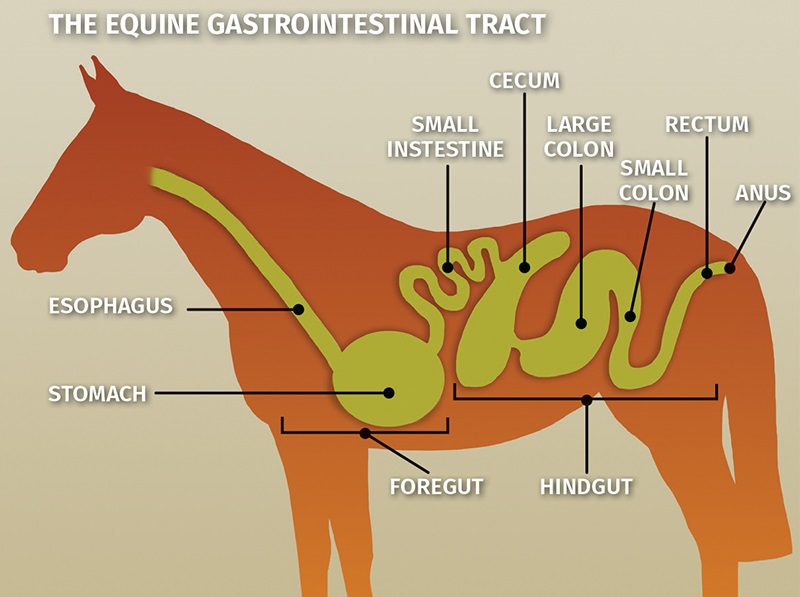
By contrast, horses also have a fermentation vat called the cecum, which is inhabited by beneficial microbes but it is situated in the hindgut of the horse. Anything the horse eats goes through the foregut or true stomach before arriving in the hindgut. This anatomical detail becomes especially significant for horses with respect to their digestion of carbohydrate sources.
Carbohydrate sources such as starch and sugar are readily digested in the enzymatic environment of the foregut where they are broken down to glucose units, which can be absorbed directly into the blood stream. Absorption of glucose arising from digestion in the foregut causes a rise in blood glucose of the horse, stimulating insulin production by the pancreas. Insulin acts to facilitate the movement of the glucose out of the blood stream into body tissues.
Starch or sugar, which resist either enzymatic digestion in the foregut or have been fed in an amount in excess of what the foregut can readily process, move on through the digestive tract into the cecum and potentially into the large colon. There they are fermented by beneficial microbes into end products called volatile fatty acids or VFA for short. VFA can be absorbed through the gut wall and transported to the liver via the blood stream where they are utilized as energy by the horse.
Starches and sugars in the hindgut are fermented very rapidly and the VFA can accumulate. This can cause a significant change in the pH environment of the cecum. Many of the beneficial bacteria living in the hindgut are very pH sensitive and may not survive a significant increase in acidity brought on by a sudden introduction of readily fermentable carbohydrates into the hindgut. Sensitive microbial populations die off and this can be detrimental to the health of the horse. Sudden diet changes for horses, especially those including starches and sugars, can lead to colic, laminitis, and/or colitis.
Related: The Wrap on Horse Blankets
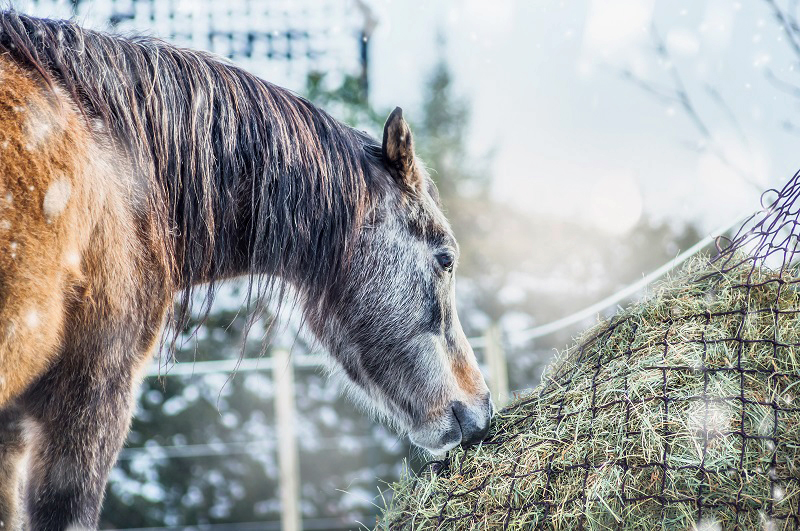
Feed small meals often. Slow feeder hay nets simulate grazing behaviour, allowing the horse to eat small amounts of forage over a longer period of time, which supports a healthier environment in the hinggut. Photo: Shutterstock/Vicuschka
Complex carbohydrates such as fibre in the form of cellulose and hemicellulose, as well as complex sugars such as fructan polysaccharides (called fructan), resist enzymatic digestion in the foregut and as a result are available for fermentation by the microbes living in the hindgut. These complex carbohydrates are usually more slowly fermented by the hindgut microbes, thereby reducing the risk of an accumulation of acidic VFA. Hay is a rich source of complex carbohydrates contributing fructan, cellulose, and hemicellulose to equine diets. Horses are well adapted to utilize these complex carbohydrates as a safe energy source through healthy hindgut fermentation.
Related: Winter Watering Options for Your Horse Farm
How Does This Relate to the Hay Analysis?
It is always a good idea to analyze the hay you plan to feed your horses for its nutrient content. A hay analysis will provide you with valuable information including many nutrients, but for the horse with chronic diarrhea we want to pay particular attention to the carbohydrate fractions. These are expressed as NSC, WSC, starch, ADF, and NDF.
Water soluble carbohydrate (WSC) is the sugar fraction of the hay and it includes both the simple, easily digested sugars glucose and fructose, as well as the complex storage sugars, fructan polysaccharides. Non-structural carbohydrate (NSC) is equal to the sum of the WSC and starch. Traditionally we have utilized NSC as a significant buying parameter for sugar- sensitive horses or horses with chronic diarrhea.
NSC = WSC + starch where WSC is sugar plus fructan polysaccharides
Acid detergent fibre (ADF) and neutral detergent fibre (NDF) are a measurement of the fibrous portion of the forage. Typically the higher the ADF and NDF, the lower the digestibility and energy of the forage.
ADF = cellulose and lignin
NDF = ADF + hemicellulose
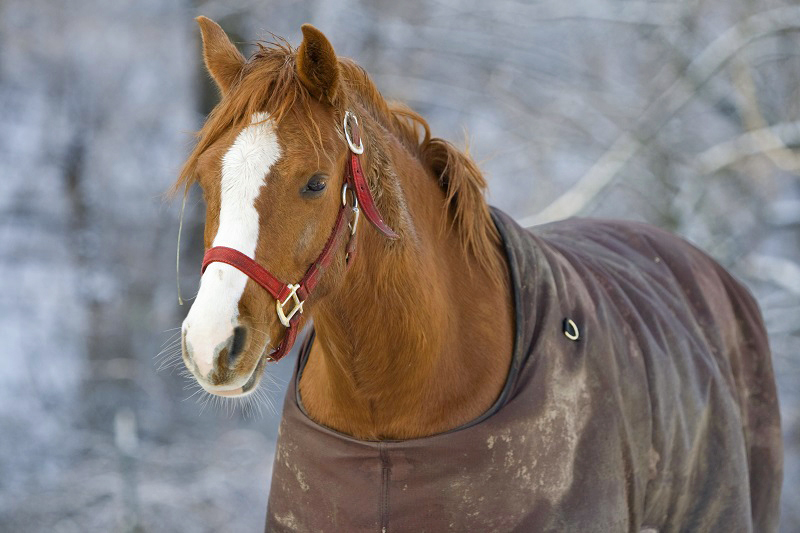
Many horses with chronic diarrhea appear to get on with their lives as usual, but are they are uncomfortable or in pain? The first step in addressing the problem should be a visit from the veterinarian to determine if other health issues could be contributing factors. Photo: iStock/PGBrace
Lignin is the indigestible part of the plant cell wall and it increases as the plant matures. This is why forages become more course and “stemmy” as they mature, with reduced digestibility.
Hemicellulose is a complex carbohydrate that is a component of the plant cell wall and it can be fermented to energy by the hindgut microbes. Hemicellulose digestibility can vary between hay cuts and varieties. This could potentially affect the energy derived by the horse through hindgut fermentation. It could also impact pH, microbial populations, and as a result, the consistency of the manure in a horse with sensitive hindgut health.
Horse owners are becoming increasingly savvy about testing hay for “sugar” content or WSC, but research is showing that for horses with sensitive hindgut health we may need to evaluate the ADF and NDF fractions in greater detail.
Related: Hay, Haylage and Silage: What's the Difference?
How Significant are Forage Varieties and Cut in Equine Digestion?
Horse owners in Canada can select from a multitude of forage varieties and cuts when purchasing hay, but most of the available hay falls into one of two categories – temperate grasses (often called C3 grass) or legumes (including alfalfa). Cool season C3 grasses are well-adapted to grow in temperate climates, but they can grow in areas with hotter drier summers and harsher winters as well. C3 grasses include timothy, orchard grass, tall fescue, brome, and rye grass.
All forages must be able to store the sugar produced during photosynthesis as complex carbohydrate to allow them to go dormant when winter comes. C3 grasses store sugars as fructan polysaccharides or fructan. Legumes like alfalfa do not store sugars as fructan but as starch.
Legumes also have much less hemicellulose, another one of those complex carbohydrates that make up the cell wall of the plant. Instead, alfalfa is a good source of pectin, another complex carbohydrate. Pectin can also yield energy to the horse through fermentation by the hindgut microbes, and is a very hindgut- friendly source of energy for horses.
The variety and the cut of any C3 grass usually has little to do with whether it will be high or low WSC, or a high or low ADF/NDF forage. These characteristics are almost completely determined by the agronomic practices of the grower. In other words, you can’t assume that hay purchased from a grower this year will be the same analysis as the same cut and variety of hay purchased from the same grower last year. If you are looking for a “low sugar” hay you are best to seek a lab analysis rather than look at the cut or variety of the hay before buying.
The Significance of the ADF/NDF Fraction
While it is important to source low WSC hay for the horse with chronic diarrhea, some very sensitive horses will get chronic diarrhea even on a low sugar hay, or one with WSC less than 10 percent on a dry matter basis. Plentiful peer-reviewed research in the ruminant species has shown that the NDF fraction of C3 grasses can be rapidly fermentable in the rumen and yield quick energy in the form of VFAs for lactating dairy cattle. NDF fractions in grass hay are utilized as energy for horses as well through fermentation by bacteria living in the large colon. Although not yet well researched in the equine world, it is logical to “connect the dots” and assume that possibly these easily fermentable fibre fractions in hay may be changing hindgut environment. They are fermenting rapidly and are causing pH changes in the hindgut, which could be detrimental to hindgut health and potentially causing or exacerbating a colitis-type condition in some of our horses.
Related: The Healthy Senior Horse
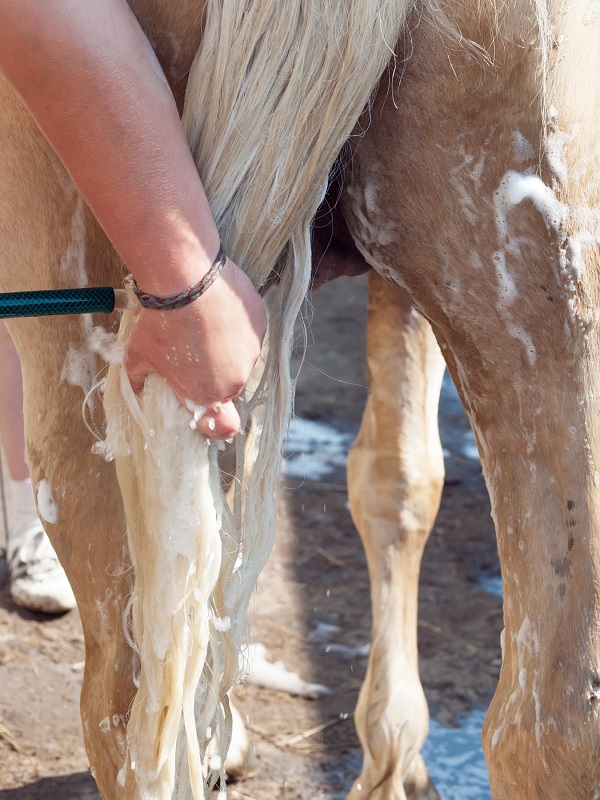
Winter grooming can be a challenge for the owner whose horse has chronic diarrhea and needs frequent backside and blanket washing to get rid of encrusted manure. Photo: Canstock/Anakondasp
What Can You Do About It?
Chronic diarrhea in horses is one of the more frustrating management issues a horse owner must face. Usually these horses improve on pasture in the summer, but by the time we get into November and horses are back on a full hay diet it can become a significant issue once again. Many horses seem to just get on with their jobs despite having a poopy hind end, but one has to wonder if they are in pain. Certainly the condition looks and behaves like a colitis, which can’t be comfortable. A manure-coated dock area could potentially result in hair loss and skin irritation for the horse as well.
The first thing to do when tackling a problem of chronic diarrhea is to consult with your veterinarian to rule out other health problems such as teeth, parasites, or chronic colitis due to other health issues. Once you have determined that your horse has a clean bill of health, you can start to evaluate other options.
If you are feeding significant amounts of concentrate containing starch and/or sugar to your horse, ensure that the meals stay small and are adequately spaced out during the course of the day. The larger the meal of starch, the greater the likelihood of undigested starch moving into the hindgut. This will most definitely exacerbate the problem.
Have a serious look at your hay analysis. You may want to consult with an equine nutritionist or your veterinarian to do this. Hay that is over 10 percent WSC on a dry matter basis will be more likely to cause the problem, but hay that was grown under ideal conditions by a commercial grower with an ADF value in the range of 35 percent or less will be likely to have high fibre digestibility and could be contributing to the issue.
Related: Test Your Horse Hay Knowledge
Dilution is the Solution
If you suspect that your hay is the cause, the most effective way to alleviate the problem is to dilute that hay with another hay, ideally of lower and/or slower digestibility. This could take the form of soaked alfalfa grass cubes or even the inclusion of some lower protein (less than 14 percent DM basis) high ADF (38-40 percent DM basis) grass alfalfa hay. A mature-cut grass alfalfa hay included in the diet can often help; second cut can be a good choice. Alfalfa is low in WSC naturally and a second cut grass alfalfa will contain a good ratio of grass to alfalfa. It could potentially be more slowly fermented in the hindgut than a C3 grass hay, yet still yield good energy. Alfalfa also contains less hemicellulose than grass hay. Hemicellulose is one of the carbohydrate fractions that we know can ferment readily in ruminant diets. It is safe to assume it could be doing the same in equine diets.
For the horse with chronic diarrhea, consider diluting hay intake with forage substitutes such as soaked soy hulls. Substituting beet pulp for hay as a forage alternative for the sensitive horse doesn’t always help as it seems to exacerbate the problem, probably because of its own inherent highly fermentable carbohydrate fractions.
Tools such as slow feeder hay nets can help to slow intake and help support a healthy hindgut environment. Bacterial probiotics and prebiotics such as yeast can help repopulate a stressed hindgut with “good bugs,” but it is important to select a probiotic that is protected in some way to ensure it actually makes it into the hindgut and doesn’t get digested as protein in the foregut. Remember, the hay question should be addressed before other solutions are explored.
Related: The Impact of Antibiotics on the Equine Gut
Conclusion
Alleviating chronic diarrhea in your horse is a multifaceted issue and will likely involve some trial and error on your part, along with diet decisions. A hay analysis is important. Consider consulting someone who can help you interpret a forage analysis to better understand the results. Start sourcing forage for your sensitive horse early in the year, and always introduce new hay gradually. Make a practice of feeding small meals often as much as possible. Remember, dilution can be an effective solution for sensitive horses. Be ready to make adjustments to your feeding regime for the sensitive horse as the winter progresses.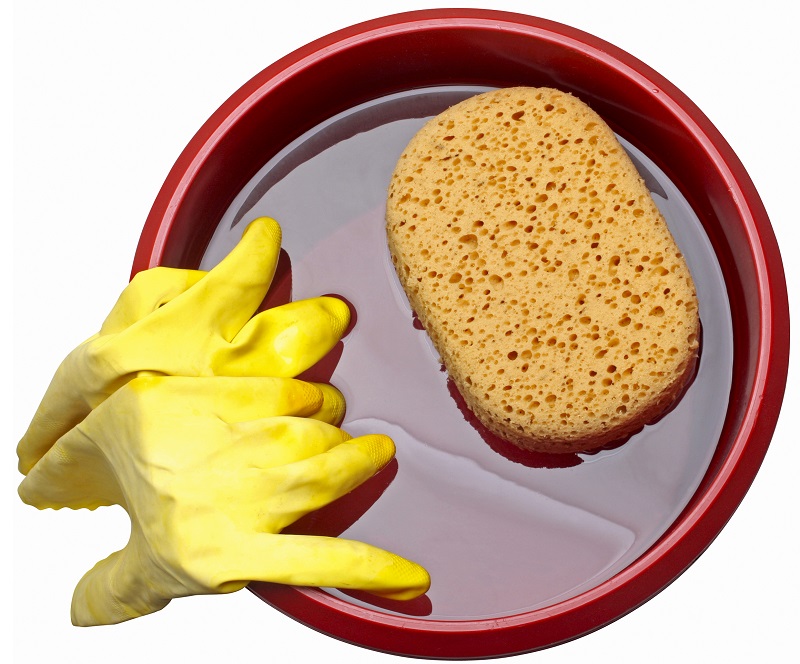
Photo: Shutterstock/Helgason
Finally, remember that the condition will probably improve with spring pasture, so don’t despair in January when your hands are freezing as you wash under your horse’s tail before you go for a ride. Keep a bucket, sponge, and some additional clean blanket leg straps on hand for those frustrating days when some minor variation in your horse’s life has caused him to get “loose” again. And remember, if the situation deteriorates and your horse appears to be uncomfortable, stressed, or in pain, always call the veterinarian.
Related: Winter Water Woes and Equine Colic Prevention
Related: Horse Care Through the Seasons



